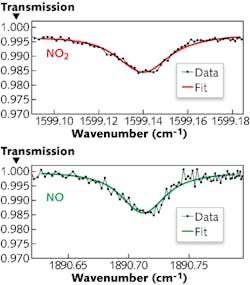A dual-wavelength quantum-cascade laser (QCL) for use in spectroscopy has been created by scientists from the Swiss institutions Empa (Dübendorf), ETH Zürich, and FHNW (Windisch). The laser emits single-mode light at 1600 and 1900 cm-1 (6.25 and 5.26 μm, respectively); these wavelengths are specifically suitable for simultaneous spectroscopic detection of nitric oxide (NO) and nitrous oxide (NO2), both (called NOx) of which are products of incomplete combustion (for example, in internal-combustion engines) and can cause smog if present in high enough quantities in the atmosphere. An experimental spectrometer setup detected the two substances to concentrations of 0.5 part per billion (ppb) for NO and 1.5 ppb for NO2 (see figure).
The QCL has a common active waveguide consisting of a stack of two single-wavelength active regions and operates at temperatures up to 30°C, producing 5 nm pulses. The threshold currents for the two regions are 0.8 A (3.6 kA/cm2) at 1900 cm-1 and 1.0 A (4.4 kA/cm2) at 1600 cm-1, allowing both regions to be powered using the same driving conditions, also allowing time multiplexing. Linewidths are 0.025 and 0.030 cm-1 at 1600 and 1900 cm-1, respectively. The spectroscopic setup contained an astigmatic-mirror multipass gas cell by Aerodyne Research (Billerica, MA) which reflected the QCL beam 182 times to produce a 36 m optical path, along with a mercury cadmium telluride detector with a noise-equivalent power of 1 pW/Hz1/2 made by Vigo (Ozarow Mazowiecki, Poland). The field-portable setup was tested on an engine test bench with a diesel engine as NOx source, and also used elsewhere to test ambient air. A second-generation version of the QCL is planned. Reference: Jana Jágerská et al., Opt. Express (2015); http://dx.doi.org/10.1364/OE.23.001512.

